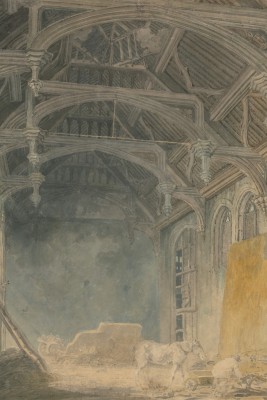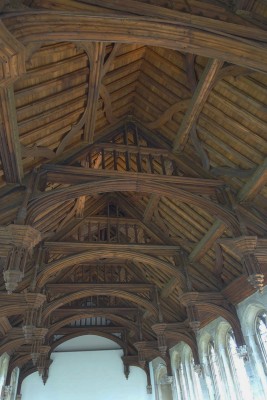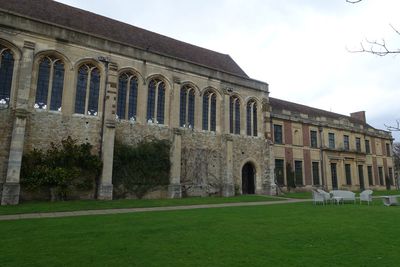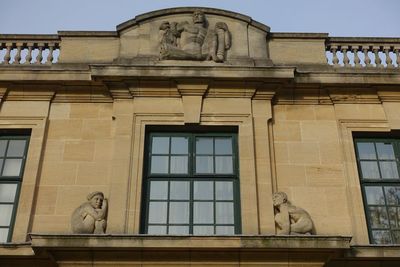Eltham the Courtauld's Way
(vero;2022-Feb-05)
You can also check our photo gallery dedicated to Eltham Palace.
 Eltham Palace is not any palace: it was already mentioned in the Domesday Book of 1086 as property of Odo, Bishop of Bayeux, Earl of Kent, and younger brother of William the Conqueror. It passed to the Crown in the early 1300s and had its heydays in the 14th and 15th centuries. It provided a welcome escape from London, where the King and the Court loved to retreat for hunting, enjoying its setting high on a ridge above the Thames with nice views on the countryside and the city.
Eltham Palace is not any palace: it was already mentioned in the Domesday Book of 1086 as property of Odo, Bishop of Bayeux, Earl of Kent, and younger brother of William the Conqueror. It passed to the Crown in the early 1300s and had its heydays in the 14th and 15th centuries. It provided a welcome escape from London, where the King and the Court loved to retreat for hunting, enjoying its setting high on a ridge above the Thames with nice views on the countryside and the city.  Its destiny is linked to another palace, Greenwich, which Henry VII developed in the 1450s and became one of his main residences, relegating Eltham to the role of Royal Nursery: the future Henry VIII and his siblings spent their childhood there, a short distance away from Greenwich. Henry VIII made some enlargements to the palace during his reign but shifted soon his attention to Hampton Court which became his preferred palace with Greenwich as second retreat, easily accessible from Hampton and Westminster by the river Thames. So it came that Eltham lost its importance and started a slow downward slide, poorly maintained and forgotten. By the 17th century the palace was falling into ruin and for 200 years after the Civil War it was used as a farm, the medieval Great Hall became a barn and the surrounding buildings got tenanted.
Its destiny is linked to another palace, Greenwich, which Henry VII developed in the 1450s and became one of his main residences, relegating Eltham to the role of Royal Nursery: the future Henry VIII and his siblings spent their childhood there, a short distance away from Greenwich. Henry VIII made some enlargements to the palace during his reign but shifted soon his attention to Hampton Court which became his preferred palace with Greenwich as second retreat, easily accessible from Hampton and Westminster by the river Thames. So it came that Eltham lost its importance and started a slow downward slide, poorly maintained and forgotten. By the 17th century the palace was falling into ruin and for 200 years after the Civil War it was used as a farm, the medieval Great Hall became a barn and the surrounding buildings got tenanted.
That is, until Stephen and Virginia Courtauld came to its rescue. But have you ever heard of the Courtaulds?
They originated from a Huguenot family who emigrated to England around 1720 and turned to textiles in the second generation (1794) where they made their fortune. Two brothers of this family, Samuel (1876-1947) and Stephen (1883-1967) became quite prominent in the 20th century. Samuel held the reins of the company and further expanded the group's fortune by developing and manufacturing rayon (a type of viscose). He was not only a successful industrialist but also a passionate art collector, accumulating an important collection which he bequeathed to the state and is now open to the public (see Somerset House and the Courtauld Gallery).
Stephen, the youngest, is the one we are interested in. On Wikipedia, his occupation is listed as philanthropist. Ideal occupation to spend without counting (he never worked in his life), have fun and enjoy life. He travelled extensively, was an ardent mountaineer and pursued cultural and philanthropic interests, collecting works of art on the way. He met his future wife Virginia (Ginie) Peirano (1885-1970) in 1919 on a holiday in the Italian Alps; she was at the time married to an Italian count and eventually got divorced to marry him in 1923. Stephen was rather introverted, studious and serious, Ginie was very social and outgoing, quite eccentric and frivolous: an amazing cocktail. They lived in Grosvenor Square in London and embraced the lifestyle of the very rich, giving ostentatious parties to their friends or touring the world in their yacht, the Virginia. They were noted patron of the arts, Stephen was involved with the Royal Geographic Society and engaged in the film industry as financial backer and chairman of the Ealing Studios.
Come 1933, Stephen and Ginie were by then looking for a new place to live, near enough to London but in the countryside: they ended up taking a ninety-nine year lease from the Crown to settle down at Eltham Palace.
 They renovated what was left, saved the splendid medieval Great Hall and attached a modern residence to it. To do this, they called upon the top architects Seely & Paget and the most prominent decorators of the day: Rolf Engströmer who designed the entrance hall, Carlton Attwood who sculpted the outside reliefs of the modern house, Gilbert Ledward who made the decorative plaster panels enclosing the windows of the Italian Drawing Room and Mayfair's fashionable interior designer of the time, Peter Malacrida (who had already decorated their Grosvenor house and their yacht).
They renovated what was left, saved the splendid medieval Great Hall and attached a modern residence to it. To do this, they called upon the top architects Seely & Paget and the most prominent decorators of the day: Rolf Engströmer who designed the entrance hall, Carlton Attwood who sculpted the outside reliefs of the modern house, Gilbert Ledward who made the decorative plaster panels enclosing the windows of the Italian Drawing Room and Mayfair's fashionable interior designer of the time, Peter Malacrida (who had already decorated their Grosvenor house and their yacht).
 We enjoyed visiting Eltham. On one side an art-déco mansion with ultra modern facilities: underfloor heating, internal phone system with telephones in all rooms, loudspeakers and music throughout the whole house, central vacuum-cleaner, built-in furniture and en-suite bath in each of the bedrooms, gold-fittings in Ginie's bathroom, walls lined with exotic woods (sometimes marqueted) or painted in subdued colours, and on the other side this magnificent medieval building.
We enjoyed visiting Eltham. On one side an art-déco mansion with ultra modern facilities: underfloor heating, internal phone system with telephones in all rooms, loudspeakers and music throughout the whole house, central vacuum-cleaner, built-in furniture and en-suite bath in each of the bedrooms, gold-fittings in Ginie's bathroom, walls lined with exotic woods (sometimes marqueted) or painted in subdued colours, and on the other side this magnificent medieval building.
Stephen was 40 and Ginie 38 when they married and the couple remained childless. They had a love for pets, the most famous one being Mah-Jongg, a lemur which they had adopted and lived with them for good fifteen years: he was part of the family with his own "bedroom" in the palace and a special conduit cum ladder which enabled him to roam from one level to the other of the house. All very eccentric. The Courtaulds entertained a lot and lavishly (think Great Gatsby) with extravagance and insolence: very nouveau-riche and decadent… The whole was very ostentatious but difficult to resist.
The craziest thing is that after investing so much energy and money in the project, the Courtaulds left Eltham Palace in May 1944 after only eleven years. They moved to Scotland and finally settled in Zimbabwe. The reason? The house was on the path of German bombers during the Blitz: a part of the Great Hall's roof and some glasshouses got heavily damaged in September 1940. They stayed nevertheless for most of the war, still entertaining but things had changed: servants were called to war duty, many friends dispersed, the time of lavish parties was over, it was not the same anymore and life grew heavy on them…
After they left, the lease was taken over by the Army, which used the building as a training centre for officers until 1992. The palace, still owned by the Crown, was then entrusted to English Heritage for maintenance and opening to the public.
Thinking about it, the Courtaulds were in fact the Jeff Bezos or Mark Zuckerberg of the time. The world does not change, everything is possible and permitted to the ones who can afford it… This leaves a bitter aftertaste, even if one admires the beauty of the place and is ecstatic about this extravagant luxury. On the other side, if it were not for the Courtaulds, the Great Hall would have surely fallen into complete ruins, for ever forgotten.
Don't forget to check our photo gallery of the interior of Eltham Palace.
Want to read more? Go back to A Year with English Heritage or go on to Wellington and Apsley House or go up to Blog
$ updated from: Blog.htxt Mon 28 Apr 2025 14:55:35 trvl2 — Copyright © 2025 Vero and Thomas Lauer unless otherwise stated | All rights reserved $



